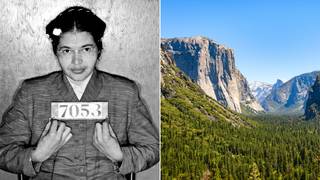
Topics
By Amy Goodman and Denis Moynihan
On Dec. 1, 1955, Rosa Parks famously refused to give up her seat on the bus to a white passenger in Montgomery, Ala., thus launching the modern-day civil-rights movement. Monday, Feb. 4, is the 100th anniversary of her birth. After she died at the age of 92 in 2005, much of the media described her as a tired seamstress, no troublemaker. But the media got it wrong. Rosa Parks was a first-class troublemaker.
Professor Jeanne Theoharis debunks the myth of the quiet seamstress in her new book “The Rebellious Life of Mrs. Rosa Parks.” Theoharis told me, “This is the story of a life history of activism, a life history that she would put it, as being ‘rebellious,’ that starts decades before her famous bus stand and ends decades after.”
She was born in Tuskegee, Ala., and raised to believe that she had a right to be respected, and to demand that respect. Jim Crow laws were entrenched then, and segregation was violently enforced. In Pine Level, where she lived, white children got a bus ride to school, while African-American children walked. Rosa Parks recalled: “But to me, that was a way of life; we had no choice but to accept what was the custom. The bus was among the first ways I realized there was a black world and a white world.”
In her late teens, Rosa met Raymond Parks, and they married. Rosa described Raymond Parks as the first activist she had ever met. He was a member of the local Montgomery NAACP chapter, and, when she learned that women were welcome at the meetings, she attended. She was elected the chapter’s secretary.
It was there that Rosa met and worked with E.D. Nixon, a radical labor organizer. Rosa Parks was able to attend the Highlander Folk School in Tennessee, in 1955. The school was a gathering place for activists—black and white together—committed to overcoming segregation, and for developing strategies and tactics for nonviolent resistance to it. It was there that Pete Seeger and others wrote the song “We Shall Overcome” as the enduring anthem of the civil-rights movement.
Parks returned to Montgomery and her job as a seamstress. On Dec. 1, 1955, she left work and got on the bus to go home. “The driver said that if I refused to leave the seat, he would have to call the police. And I told him, ‘Just call the police,’” Parks told Pacifica Radio in April 1956. “The time had just come when I had been pushed as far as I could stand to be pushed.” Her arrest that day sparked the Montgomery Bus Boycott, which would last more than a year. It was led by a young minister who had just moved into town: Dr. Martin Luther King Jr. Rosa Parks helped to launch Dr. King. Some 50,000 African-Americans carpooled, used church vehicles, rode in African-American-owned taxis and walked. The boycott crippled white businesses and the public transit system. Parks and others mounted a court challenge to the segregation, and in June 1956, a federal court ruled segregation on buses as unconstitutional.
The Parks moved to Detroit. She continued her work, responding to the Detroit riots in 1967, conferring with members of the Black Power movement like Stokely Carmichael. She opposed the war in Vietnam. Historian Theoharis notes that Park’s biggest hero was Malcolm X. In the 1980s, Rosa Parks fought against apartheid, joining protests outside the South African embassy in Washington, D.C.
When she met Nelson Mandela after his release from prison, he told her, “You sustained me while I was in prison all those years.”
When Rosa Parks died, she was the first African-American woman to lie in state in the Capitol rotunda. I raced down to Washington, D.C., to cover her memorial service. I met a young college student and asked her why she was there standing outside with so many hundreds of people listening to the service on loudspeakers. She said proudly, “I emailed my professors and said I won’t be in class today; I’m going to get an education.”
Rosa Parks has much to teach us. In fact, she and other young women had refused to give up their seats on the bus before Dec. 1, 1955. You never know when that magic moment will come. This Feb. 4, the U.S. Postal Service will release a Rosa Parks Forever stamp, a reminder of the enduring mark she made. Rosa Parks was no tired seamstress. As she said of that brave action she took, “The only tired I was, was tired of giving in.”
Amy Goodman is the host of “Democracy Now!,” a daily international TV/radio news hour airing on more than 1,000 stations in North America. She is the co-author of “The Silenced Majority,” a New York Times best-seller.
© 2013 Amy Goodman












Media Options